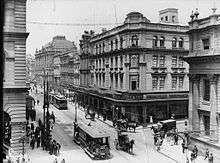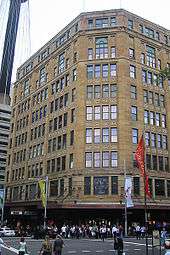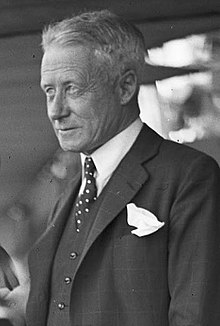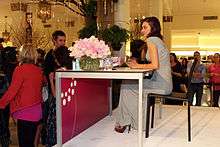David Jones Limited
David Jones Pty Limited, trading as David Jones (colloquially DJs), is an Australian upmarket department store, owned since 2014 by South African retail group Woolworths Holdings Limited.[3]
| Subsidiary | |
| Industry | Retail |
| Founded | 1838, Sydney, Australia |
| Founder | David Jones |
| Headquarters | , |
Number of locations | 47 |
Area served | Australia, New Zealand |
Key people | Ian Moir (Group CEO, Woolworths Holdings Ltd) |
| Products | Cosmetics, Fashion, Homewares, Furniture, Electrical, Food |
| Revenue | |
Number of employees | 7200 (2014)[2] |
| Parent | Woolworths Holdings Limited (South Africa) |
| Website | www |
David Jones was founded in 1838 by David Jones, a Welsh merchant and future politician, after he emigrated to Australia, and is the oldest continuously-operating department store in the world still trading under its original name.[4][5]
In 1980, the Adelaide Steamship Company acquired a substantial interest in David Jones, culminating in a complete takeover. The recession of the early 1990s caused the department store assets to be floated as "David Jones Limited". For the next two decades, the company went through turbulent times, eventually leading to discussions of a merger with Myer, and then, in 2014, a takeover by South African retail group Woolworths Holdings Limited. In 2016, Woolworths sold the iconic 1938 Market Street store and announced the relocation of DJ's head office to Richmond, Victoria.[6]
David Jones Limited currently has 45 stores located in most Australian states and territories (except Tasmania and the Northern Territory). David Jones' main competitor is the larger, upmarket department store chain Myer. On 28 July 2016, David Jones opened its first New Zealand store in Wellington after buying Kirkcaldie & Stains,[7] and on 21 November 2019, opened its first Auckland store in the newly-developed Westfield Newmarket.[8]
History

David Jones, a Welsh merchant, met a Hobart businessman, Charles Appleton, in London. Appleton had established a store in Sydney in 1825 and Jones subsequently established a partnership with him, moved to Australia in 1835, and the Sydney store became known as Appleton and Jones. When the partnership was dissolved in 1838, Jones moved his business to premises on the corner of George Street and Barrack Lane. Jones survived the depression of the 1840s, and by 1856 had retired from active management of the business. A few years later when the firm failed, he returned to manage its affairs and within a few years had fully discharged all obligations to his creditors.[9]
By 1887, the George Street store had been rebuilt and a mail-order facility was introduced. A factory was opened in Marlborough Street, Sydney, to reduce reliance on imported goods. On the death of the founder, his son, Edward Lloyd Jones (1844–1894), led the company. At 18, Edward Lloyd Jones, Jr. (1874–1934) journeyed to England and entered the London office of David Jones. On his return to Australia, he gained pastoral and cattle experience in the Burnett district of Queensland. He re-entered the family business upon the death of his father in the train disaster at Redfern in 1894. David Jones was then a private company, but in 1906, it became a public company.[10] Edward Lloyd Jones, Jr. became chairman of directors and held that position until he resigned in 1921. The Elizabeth Street store was opened in 1927 under the guidance of chairman Charles Lloyd Jones. A further store was opened in Market Street, Sydney, in 1938. A small branch was located in the Australia Hotel on Martin Place. In 1954, a state banquet was held for visiting Queen Elizabeth II in the restaurant of the Elizabeth Street store.[4]
1940s - 1980s

Regional NSW and interstate entry
Within New South Wales, David Jones established its first store in Newcastle by acquiring Scott's on Hunter Street in 1957 (closed 2011), and [11] in Wollongong, the retailer Walter Lance and Co. in 1960. David Jones acquired and then converted the Big W Department Stores at Kotara Fair and the two-storey Big W at Warrawong in 1971. The Warrawong store closed in February 1986. A store in Wagga Wagga was added due to the purchase of David Copland and Co in 1953 (closed 1971).
David Jones' expanded into Victoria in the 1960s and in 1982 acquired the three stores of Buckley & Nunn located in Bourke Street, Northland, and Chadstone (closed the latter in 1983). In 1987, David Jones purchased the former GJ Coles store and building at 299 Bourke Street, Melbourne, converting it into a David Jones store. David Jones also owned the former Georges store in Collins Street, Melbourne between 1981 and 1995. In South Australia there were the acquisitions of Charles Birks & Co (Adelaide) in 1954 and John Martin's (Adelaide) in 1985. In Western Australia, it acquired Bon Marche (Perth) in 1954 (closed 1979), Foy and Gibson in 1964 (closed 1978), and Aherns (Perth) in 1999. In Queensland, David Jones purchased Finney Isles (Brisbane) in 1955, McKimmons (Townsville) in 1960 (relocated from Flinders Street and then closed in 1994), T.C. Beirne (Brisbane) in 1961, Marsh and Webster (Mackay) in 1963 (closed 1981), Boland's (Cairns) also in 1963 (relocated to Earlville in 1984, since closed), Wyper Bros. (Bundaberg) in 1972 (closed 1981), and Stuparts (Maryborough) in 1977 (closed 1981).
United States
In 1974, David Jones acquired a group of 12 stores in the United States, called Buffum's. These were ultimately rolled into Adelaide Steamship Company and closed by that company in May 1991.
David Jones Art Gallery
A significant feature of the Elizabeth Street shop, contributing greatly to its aura of quality and exclusivity, was the David Jones Art Gallery founded in 1944. Directors included Will Ashton (1944–47), Marion Hall Best (1947–49), John Amory (1949–50), M P Ferrandiere (1950–53), George Duncan (1953–63), Robert Haines (1963–76), Brian Moore (1976–84), and Peta Phillips (1984–92). Among the many drawcards were the Dobell exhibition of 1944, the Duke of Bedford's collection in 1962, and the Mendel Collection of Modern Painting, also in 1962. Prominent arts societies that held annual exhibitions there included the Australian Art Society, the Society of Artists, Australian Watercolour Institute, Contemporary Art Society, and Society of Sculptors and Associates. Prize exhibitions held in the Gallery included those sponsored by W D & H O Wills and Transfield.[12]
Dajonians Repertory Society
Throughout the 1930s and '40s, the Sydney store supported the Dajonians Repertory Society, a Staff Club amateur theatre group. Their plays were variously performed in the David Jones theatrette and such theatres as St James' Hall and Independent Theatre. They engaged the services of a permanent producer (Carl Francis throughout the '30s and Frederick Hughes from 1940) and produced six plays a year, mostly light comedies by recognised playwrights such as J. B. Priestley.[13] Through this time the company was led by Sir Charles Lloyd Jones until his death in 1958. By 1959, the store network had expanded to eight stores, with expansion focused upon the burgeoning new suburbs of Sydney.[4]
1980s - 2000s
In 1980, the Adelaide Steamship Company, headed by John Spalvins, acquired a substantial interest in David Jones, culminating in a complete takeover that took the company out of the Jones' family hands for the first time in its history. Through the 1980s and into the 1990s, the two companies involved themselves in a complex company structure whereby they each owned about half of each other, and financed by huge borrowings, acquired a portfolio of other companies. Other acquisitions made by Adelaide Steamship included Petersville Sleigh, Tooth & Co, Penfolds, and numerous others.[14]
The recession of the early 1990s caused the nervous lenders (over 200 banks) to demand the return of their assets. This forced the liquidation of the portfolio at "fire-sale" prices and led the two companies into bankruptcy; the worthless Adelaide Steamship Company was renamed "Residual Assco Ltd" and was delisted. The worthless David Jones Limited was renamed "DJL". A number of the assets with value were very successfully sold off via public floats, in particular, National Foods, Woolworths, and the department store assets of DJL were floated as "David Jones Limited". In 1995, David Jones announced an $800 million public float of the David Jones and John Martin retail operations. The "new" David Jones Limited was subsequently listed on the Australian Stock Exchange with a new ASX code of DJS.[10] The separation and public float of the department store assets in 1995 resulted in structural and cultural changes, which had periods of stagnancy and high staff turnover. Changes in management had DJs falter in the late 1990s. Shares initially offered at A$2 fell as low as A$0.90.[10]
2000s - present
In 2003, after a 20 million dollar loss, a strategic review in the company led to the closure of David Jones Rockingham, and the exit of the lease of David Jones Fountain Gate, as well as the closure of the loss-making David Jones Online web-based business and its gourmet food retail stores, Foodchain. It revitalised many of its stores, including its flagship Elizabeth Street and Market Street stores in Sydney (two individual buildings, linked both underground and via air bridge through Westfield Sydney). During this period, sales growth and profit growth were not increasing despite a consumer spending boom and the securing of exclusive deals with Australian and international brands. In this period, the share price was volatile; it reached a high over $4.50.[15] The global downturn in 2009 affected David Jones, reporting a sales decline of 6.4% to $1,061.2m in the first half of 2009.[16]
In June 2010, CEO Mark McInnes resigned after allegations that he had sexually harassed a female employee.[17] McInnes' successor, Paul Zahra, led the company through significant restructuring, including the expansion of the online retail presence until October 2013, when he announced his intention to resign.[18] Zahra retained his position, however, on account of strong shareholder support against Board Chairman Peter Mason, who eventually resigned along with two other directors who had been accused of insider trading.[19][20]
Proposed Myer merger
In October 2013, Myer approached David Jones with a conditional, nonbinding, indicative proposal for a potential merger of the two companies.[21] Myer believed the combined group would have generated pro forma sales and earnings before interest and taxes in 2013 around $5.0 billion and $364 million, respectively. In addition, Myer expected that a merger could have achieved more than $85 million of ongoing annual cost synergies within three years, primarily driven by structural efficiencies. The board of David Jones rejected the offer in November 2013.[22] In February 2014, Myer again approached David Jones offering to buy the company at market value, with David Jones having a market capitalisation of $1.7 billion. Myer also indicated that its reappointed chief executive Bernie Brookes would be capable of managing the combined entity should the merger occur.[23] David Jones acknowledged the letter stating it would consider any proposal that is in the best interest of its shareholders but made no further comment.[24]
Takeover by Woolworths South Africa
In April 2014, Myer withdrew its proposed merger of equals following on from David Jones' announcement that it had recommended a $4.00 cash per share proposal and entered into a scheme implementation deed with South African retail group Woolworths, implying a market capitalisation of $2.15 billion.[25][26] The takeover bid was approved in July 2014 by the Federal Court of Australia.[27] In mid-August 2014, despite the previously stated intention by Woolworths to retain CEO Paul Zahra, Zahra announced his resignation once more amid indications of significant differences between strategy and the future of the company, giving three months' notice to ensure a smooth handover.[19] Woolworths then announced that Country Road CEO Iain Nairn would succeed Zahra as chief executive.[28]
Woolworths South Africa sold the 1938 Market Street store in 2016, with the plan that DJ's would lease and occupy the site until late 2019.[6] The plan was that this would result in the closure of the store, with the nine floors of homewares, furniture, electricals, and menswear being merged into the 1927 flagship Elizabeth Street store, which was to be renovated and have its floors devoted to shopping space expanded from eight to 12.[6]
Entry into New Zealand
In July 2015, the Wellington, New Zealand department store Kirkcaldie & Stains agreed to be purchased by Woolworths (South Africa). The existing Wellington store closed in 2016. It reopened on 28 July 2016 as the first David Jones' store in New Zealand. The store fit-out has cost about $AU20 million, more than originally budgeted. The David Jones website does not provide delivery to New Zealand, remaining a solely Australian trading website.
Management

Executive chairmen
- David Jones, 1838–1868
- Edward Lloyd Jones, 1868–1894
- Edward Lloyd Jones, Jr., 1894–1921
- Sir Charles Lloyd Jones, 1921–1958
- David Lloyd Jones, 1959–1961
- Charles Lloyd Jones, Jr., 1961–1980
Nonexecutive chairmen
Chief executive officers
- John Spalvins, 1980–1991
- Rod Mewing, 1991–1994
- Chris Tideman, 1994–1997
- Peter Wilkinson, 1997–2002
- Mark McInnes, 2002–2010
- Paul Zahra, 2010–2014
- Iain Nairn, 2014–2015
- John Dixon, 2015–2017[32]
- David Thomas, 2017–2019[33]
- Ian Moir, 2019 -
David Jones Store Formats
David Jones Department stores are the high class department stores, found in indoor and outdoor shopping centres throughout Victoria, New South Wales, Queensland, Western Australia, South Australia and Australian Capital Territory in Australia, and Auckland and Wellington in New Zealand. There are 47 David Jones Department stores currently in operation.
David Jones Food Hall/Food stores are small supermarkets, similar to Coles or Woolworths, although higher class and smaller in size. They are often found next to or near David Jones stores, although recently David Jones entered a deal with BP to convert some of their BP Shop convenience stores in David Jones Food stores. There are now ten locations of David Jones Food stores at BP stations all located in Victoria and New South Wales, six in Victoria being BP Bayside, BP Brighton, BP Clarendon, BP Glen Waverley, BP Greensborough and BP Ringwood and four in New South Wales, being Artarmon, Ashfield, Kingsford and Rozelle.
Branding

David Jones' branding—a black-on-white houndstooth pattern—is one of the most recognised corporate identities in Australia. A government-sponsored panel judged it in 2006 as one of Australia's top-10 favourite trademarks.[34] The iconic design was the result of a 1967 rebranding exercise by Charles Lloyd Jones, Jr., who desired that the store would be so well known by the design as to not require the use of the name on the packing. It was inspired allegedly from the houndstooth design on a Miss Dior perfume bottle of his mother's, Hannah Jones.[35] On 25 July 2016, David Jones' introduced a new logo, with a revised font style and removed references to the houndstooth online.
Slogans have been used for some time at David Jones'. Often, the slogans have been used for multiple decades and have become the definition of the David Jones' offer for a generation. Past slogans include "For Service" (1960s), "There's no other store like David Jones" (1980s and 1990s), "The most beautiful store in the world" (1980s), "Was. Is. Always" (2010s), "'Live an extraordinary life" (2014–2016), and "One name: endless possibilities" (2016-present).
David Jones has for some decades used models and "personalities" as a way of creating cut through in advertising. In the late 20th century, it was Maureen Duval, who also hosted Good Morning Sydney part sponsored by David Jones on TEN-10 Sydney. In the current century, the new models used include Megan Gale, Miranda Kerr, and Jessica Gomes.[36][37] Kerr worked for the retailer from 2008 until 2013. On 23 March 2013, model Jessica Gomes was announced as Kerr's replacement.[38] Celebrities used by David Jones in recent times include Liz Hurley[39] and Kim Cattrall.[40]
Five stores have food halls, which are viewed as a key part of the David Jones brand, emphasising quality and style, yet have come under recent criticism.[41] The failed Foodchain experiment—effectively a smaller chain of standalone food halls—was sold to the parent company of Freedom Furniture in 2003 after it proved unprofitable.[42] It was announced in July 2016, Neil Perry, a foodservice and restaurant operator, will consult to David Jones' on the new Food Halls, including assortment, presentation, and service.
David Jones Stores

David Jones has department stores in all Australian capital cities except Hobart and Darwin, and also has stores in Kotara (Newcastle), Tuggerah, Wollongong, and Robina and Broadbeach Waters (Gold Coast).
Stores are located in city centre retail areas and enclosed shopping centres. In 2007, David Jones recast its criteria for store locations, reflecting CEO Mark McInnes' intention to concentrate on "low-risk, high-value locations".[43] Stores in Sydney at Centro Bankstown (closed July 2007) and Westfield Eastgardens (October 2007) were replaced by Myer, but David Jones replaced the Myer store in Westfield Burwood in May 2007 and opened a new store at Westfield Chermside in August 2007 and a new store at QueensPlaza, Brisbane in February 2008. The Melbourne Bourke Street stores were completely renovated in mid-2010[44] at a cost of $250 million.[45]
In January 2008, David Jones announced that the Claremont store would be closed in 2009 to allow for a complete rebuilding to reopen in 2011. The new store increased floor space by 60%.[46] David Jones' opened a new format, fashion focused format in Malvern, Victoria on 12 September 2013. On 1 May 2014, David Jones opened in Indooroopilly, Queensland. In October 2014, David Jones opened in Macquarie Centre, at the same time a number of foreign retailers opened in the centre including H&M, Zara, and Uniqlo.[47]
In March 2016, the new owners of David Jones', Woolworths South Africa, announced the sale of the nine-floor Market Street Sydney store, housing the Home, Food, and Menswear departments, which is to be incorporated into a renovated Elizabeth Street store, which will have its shopping floors increased from eight to 12. The Market Street store was opened in 1938.[6] The store closed on 16 March 2020.
In February 2017, David Jones announced a three-store deal at Westfield Shopping centres in Western Australia. The three stores are in Westfield Carousel, Westfield Innaloo (soon to be called Westfield Stirling), and Westfield Whitford City. The first store opened in Westfield Carousel in August 2018. As of May 28, 2020, the other two stores have either been put on hold, or silently cancelled. On 22 March 2018, two new stores opened, one in Stockland's expanded Green Hills Shopping Centre in East Maitland, NSW, and another in Mandurah, WA, in the Mandurah Forum Shopping Centre.
David Jones currently has 47 stores in Australia.[48]
On 22 January 2020, David Jones announced it would close a single David Jones location in Fortitude Valley, Queensland. The location in Fortitude Valley would be closing in June, 2020, after just three years of being open. This location was two levels and a newer, boutique store. David Jones stated that the store didn’t suit the location, and all staff would be relocated to nearby QueensPlaza, or another store in close proximity. This would leave 44 stores in Australia and two in New Zealand.
David Jones currently has 47 stores, 45 in Australia and 2 in New Zealand
Victoria (8)
David Jones Chadstone
David Jones Doncaster
David Jones Eastland
David Jones Glen Waverley
David Jones Highpoint
David Jones Malvern
David Jones Melbourne CBD
David Jones Southland
New South Wales (16)
David Jones Barangaroo
David Jones Bondi Junction
David Jones Burwood
David Jones Castle Hill
David Jones Chatswood
David Jones Green Hills
David Jones Hornsby
David Jones Kotara
David Jones Macarthur Square
David Jones Macquarie
David Jones Miranda
David Jones Paramatta
David Jones Sydney CBD
David Jones Tuggerah
David Jones Warringah
David Jones Wollongong
Australian Capital Territory (2)
David Jones Canberra CBD
David Jones Woden
Queensland (10)
David Jones Brisbane CBD
David Jones Pacific Fair
David Jones Carindale
David Jones Chermside
David Jones Garden City
David Jones Indooroopilly
David Jones James Street
David Jones Robina
David Jones Sunshine Plaza
David Jones Toowong Village
Western Australia (6)
David Jones Booragoon
David Jones Carousel
David Jones Claremont
David Jones Karrinyup
David Jones Mandurah
David Jones Perth CBD
South Australia (3)
David Jones Adelaide CBD
David Jones Marion
David Jones West Lakes
New Zealand (2)
David Jones Auckland
David Jones Wellington
David Jones Food Stores
David Jones Food (2)
David Jones Capitol Grand
David Jones Malvern Central
David Jones Food Hall (3)
Victoria (1)
David Jones Food Hall Melbourne
New South Wales (2)
David Jones Food Hall Bondi Junction
David Jones Food Hall Sydney
David Jones Food/BP (10)
BP/David Jones Food Artarmon
BP/David Jones Food Ashfield Croydon
BP/David Jones Food Bayside Brighton East
BP/David Jones Food Brighton
BP/David Jones Food Clarendon South Melbourne
BP/David Jones Food Greensborough
BP/David Jones Food Kingsford
BP/David Jones Food Ringwood
BP/David Jones Food Rozelle
BP/David Jones Food Tally Ho Glen Waverley
Gallery
 David Jones' previous logo, featuring the "There's no other store like" slogan
David Jones' previous logo, featuring the "There's no other store like" slogan David Jones at Woden Town Centre in Canberra
David Jones at Woden Town Centre in Canberra David Jones - second floor at QueensPlaza in Brisbane (Queen Street Mall end)
David Jones - second floor at QueensPlaza in Brisbane (Queen Street Mall end) David Jones - second floor at QueensPlaza in Brisbane (Adelaide Street end)
David Jones - second floor at QueensPlaza in Brisbane (Adelaide Street end) The former David Jones Melbourne, redeveloped in 2010
The former David Jones Melbourne, redeveloped in 2010 The Foodhall at David Jones Market Street, Sydney store
The Foodhall at David Jones Market Street, Sydney store David Jones Florist at David Jones Elizabeth Street, Sydney store
David Jones Florist at David Jones Elizabeth Street, Sydney store
Arms
 |
|
See also
References
- Sales report. "Preliminary Group Results announcement" (PDF). Retrieved 27 August 2015.
- "WHL 2014 Integrated Report" (PDF). Retrieved 8 October 2014.
- Kelly, Ross (9 April 2014). "Australia's David Jones Gets Takeover Bid From Woolworths". Wall Street Journal. ISSN 0099-9660. Retrieved 18 March 2020.
- "Story of David Jones". David Jones. Archived from the original on 15 April 2008. Retrieved 9 May 2008.
- Company History, Answers.com. Retrieved on 4 July 2009.
- Carolyn Cummins (8 August 2016). "David Jones' iconic Sydney Market Street store sold to Westfield owner Scentre Group". Sydney Morning Herald.
- Catherine Harris, James Weir & Talia Shadwell (4 June 2015). "Kirkcaldie & Stains department store to become David Jones". stuff.co.nz.
- "David Jones opens first Auckland store, along with second Westfield Newmarket site".
- "Jones, David (1793-1873) Biographical Entry". Australian Dictionary of Biography. Retrieved 22 February 2008.
- "David Jones Limited (1906 -)". Guide to Australian Business Records. Retrieved 9 May 2008.
- http://www.newcastle.nsw.gov.au/__data/assets/pdf_file/0020/17507/heritagewalkfurtherinfo.pdf%5B%5D
- Encyclopedia of Australian Art Alan McCulloch, Hutchinson of London, 1968
- "27 Jan 1940 - MUSIC AND DRAMA. The American Scene—Widespread U..." nla.gov.au.
- "Annual Report to Shareholders, 1990", The Adelaide Steamship Company.
- McMahon, Stephen (22 March 2007). "David Jones profit dazzles". Retrieved 17 March 2010.
- "ASX Release 18 March 2009" (PDF). davidjones.com.au. 18 March 2009. Retrieved 19 March 2015.
- Durie, John (18 June 2010). "David Jones CEO Mark McInnes resigns after sexual harassment complaint". The Australian. Retrieved 4 June 2018.
- Eli Greenblat; Rachel Wells (21 October 2013). "Paul Zahra quits as David Jones chief". The Sydney Morning Herald. Retrieved 24 October 2013.
- Knight, Elizabeth (12 August 2014). "Time up for Paul Zahra, David Jones' 'accidental CEO'". Fairfax Media. The Sydney Morning Herald. Retrieved 12 August 2014.
- Speedy, Blair (11 February 2014). "Turmoil at David Jones as Peter Mason leads exodus". New Corp Australia. The Australian. Retrieved 12 August 2014.
- "Myer confirms David Jones merger approach" (PDF). ASX-Media-Release, Australia. 31 January 2014. Retrieved 15 April 2014.
- "David Jones Response to Media Commentary". ASX-Media-Release, Australia. 30 January 2014. Retrieved 15 April 2014.
- "Myer announces re-appointment of CEO". ASX-Media-Release, Australia. 20 February 2014. Retrieved 15 April 2014.
- "DJS - Response to Myer Letter". ASX-Media-Release, Australia. 20 February 2014. Retrieved 15 April 2014.
- "Myer response to David Jones announcement". ASX-Media-Release, Australia. 9 April 2014. Retrieved 15 April 2014.
- "David Jones Board Recommends A$4.00 Cash per Share Proposal". ASX-Media-Release, Australia. 9 April 2014. Retrieved 15 April 2014.
- Mitchell, Sue (17 July 2014). "David Jones takeover clears final hurdle". Australian Financial Review. Retrieved 12 August 2014.
- Speedy, Blair (12 August 2014). "Iain Nairn to head David Jones as Paul Zahra quits". News Corp Australia. The Australian. Retrieved 12 August 2014.
- Bartholomeusz, Stephen (4 June 2003). "Now DJs can get back to basics". The Age. Retrieved 22 October 2014.
- Speedy, Blair (23 November 2012). "David Jones chairman Bob Savage in shock early exit". The Australian. Retrieved 22 October 2014.
- Mitchell, Sue (22 July 2014). "David Jones chairman Gordon Cairns never in doubt over Woolworths takeover". The Sydney Morning Herald. Retrieved 22 October 2014.
- "David Jones Media Centre". David Jones.
- "David Jones Media Centre".
- "IP Australia - Trademarks Centenary 2006". Australian Government. 2006. Archived from the original on 24 July 2008. Retrieved 18 August 2008.
- McGinness, Mark (17 July 2010). "Name synonymous with DJs". The Age. Retrieved 10 June 2013.
- "Catwalk an art form: Megan Gale". National Nine News. 28 February 2008. Archived from the original on 25 February 2008. Retrieved 19 June 2008.
- "Miranda Kerr the new face of David Jones". The West Australian. 24 April 2008. Archived from the original on 25 May 2009. Retrieved 19 June 2008.
- "David Jones says goodbye Miranda Kerr and hello Jessica Gomes". The dailytelegraph. 23 March 2013. Retrieved 23 March 2013.
- "Hurley's charms". The Age, Melbourne. 1 September 2005. Retrieved 18 June 2008.
- "Cattrall shows her sex smarts". Sydney Morning Herald. 18 December 2005. Retrieved 19 June 2008.
- "Food hall failing, says expert". Sydney Morning Herald. 28 January 2008. Retrieved 19 June 2008.
- "Freedom picks up Foodchain stores". The Age. Melbourne. 3 June 2003. Retrieved 19 June 2008.
- Retail blues Archived 5 June 2009 at the Wayback Machine, Business Sunday, ninemsn.com.au
- "David Jones Redevelopment - Bourke Street Melbourne". Walton Construction. Archived from the original on 2 May 2013. Retrieved 26 April 2013.
- Eli Greenblat (11 August 2010). "DJs prepares to party after its $250m facelift". Theage.com.au. Retrieved 26 April 2013.
- David Jones announces that its Claremont store will be completely rebuilt, Press Release, 30 January 2008. Retrieved 2008-11-28.
- "David Jones opens first new Sydney store in seven years". The Sydney Morning Herald.
- "Store Locations & Trading Hours". David Jones. Retrieved 12 March 2017.
- Low, Charles (1971). A Roll of Australian Arms. Adelaide: Rigby Limited. p. 29. ISBN 0-85179-149-2. OCLC 246821.
Further reading
- O'Neill, Helen (2013). David Jones: 175 Years. Sydney NSW: NewSouth Publishing. ISBN 978 174223 349 9.
- Reekie, Gail (1987). Sydney's big stores 1880-1930: gender and mass marketing. University of Sydney: Thesis (PhD), 1989.
- Valsamis, Paula (1985). The architecture of Sydney department stores 1880-1930 its ideological function in society. University of New South Wales: Thesis (BArch), 1985.